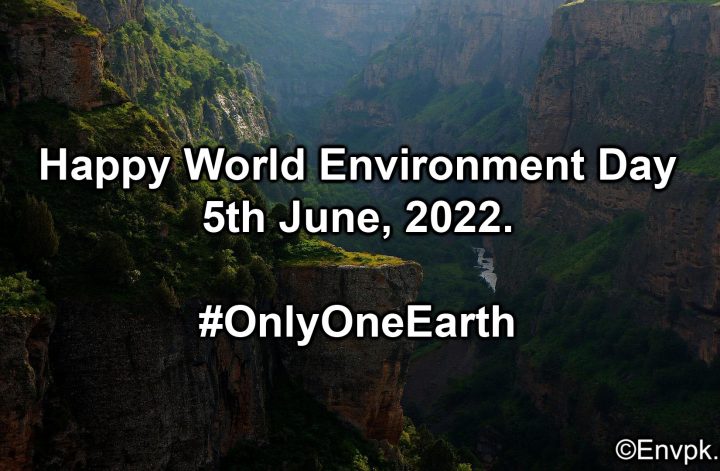By: Dr. Khalid Farooq Akbar and Syeda Khola Tazeen
Corresponding Author: kakbar5813@gmail.com
Nature is the art of God.
– Dante
Introduction
The ever-growing tsunami of human development including infrastructure expansion, urbanization, deforestation and industrialization has changed natural landscapes and is ravaging pristine wild areas. With advances in engineering and technology, there is no place left on the Earth that may be safe from human interference.
The wilderness and natural areas are being encroached constantly on a global scale. In the last four decades, nearly ten percent of total wild and natural areas of the world have been destroyed. It is feared that if this trend continues, all these valuable habitats and ecosystems will be completely destroyed within next 100 years.
A wild or natural area is an area dominated by natural processes, and its key features are naturalness, protection from disturbance, largeness, remoteness, absence of development and infrastructure. In these areas, the general public has access to see, use and enjoy for such activities as hiking, hunting, fishing, and experiencing spiritual, natural and cultural heritage qualities.
In the past, for millions of years, man used to share its natural environment with other creatures in an ecologically balanced and mutually beneficial manner. He is still therefore physiologically and spiritually part of a primeval past, still attuned to nature and its beauties. Despite his great strides in the fields of science and technology, man possesses an abiding sense of oneness with wild nature and a hidden craving for wildness and nature in different forms is part of him.
Paul Gruchow in his book, Boundary Waters: The Grace of the Wild, describes the grace of the wild in these words, “A journey into wilderness speaks to that part of our being which is not dependent upon wisdom; not to what we have learned from books, but to whatever depends upon experience with the physical world; knowing how to read a footprint in the mud, how to steer a canoe in the wind, how to make a fire in the rain, what sorts of weather the clouds and the wind foretell; where to look for a game animal, which of the mushrooms in the forest are edible, which sound in the night is sinister and benign, which bird sings overhead, what flower blooms in the marsh”.
Protection and restoration of wilderness and wild areas has gained increasing attention in recent years. During the agricultural and industrial revolutions, land and its resources such as forests, soils, livestock and water were merely considered as economic commodities and deemed more valuable than the landscape in which, these resources are located. However, in the last half century, with the enormous hike in tourism, recreation and conservation movements, has received greater attention and value for their non-commodity and natural attributes.
In addition, current developments in environmental science have highlighted many ways in which natural and wild areas support prosperity and provide resilience against global warming, loss of biodiversity and sustenance of natural biological systems. Billions of native people around the globe daily ‘connect with nature’ to meet their daily needs of food, water, firewood, and sustain their livelihoods by growing crops using water and fertile soils provided by these wild areas.
With this increased interest in intangible values of wild areas and availability of technologies and machinery to provide access to very remote areas, the natural landscapes and wild areas such as mountains, prairies, valleys, and forests and wildlife areas, have now become the fields of competition for different competitors with different motives. These include tourism development organizations, hotels, game hunting, mountaineering, research, conservation and the military etc. With increased education and commercialization trends, the traditional residents of these areas are also introducing modern methods for resource exploitation and vie to ensure their control over these areas threatening the ecological integrity and structure of these precious habitats.
Diversity of Wild Areas in Pakistan
Pakistan, though with relatively small land area, has been endowed with great archeological and bio-geographical diversity. It has been a center of Mehargarh and Gandhara cultures and Indus Civilization. Due to its length (distance from Karachi to Khunjerab is approximately 1700 km) and variation in altitude (sea coast in south to 8600 m in north), it has diverse types of habitats and ecosystems. The temperature varies from 52oC in Jacobabad to minus 30oC in Siachen and mean annual rainfall ranges from 50mm in Naukundi, Balochistan to 2030 mm in Himalayas. In its north and northwest, it has globally renowned mountain ranges of Himalaya, Karakorum and Hindu Kush. Along its western border, two famous mountain ranges, Koh-e-Sulaiman and Koh Sufaid are located. In addition, hilly areas of Murree, Swat, Dir and Chitral add variety to its natural beauty and biogeography. Baltistan has more than 100 peaks higher than 5000m and after polar region, the largest snow covered glaciers. In the south, Thar, the eighth largest desert is located.
These variations in latitude, altitude, soil, temperature, precipitation and geography have provided Pakistan with diverse types of climates, geographical regions and rich biodiversity. It has a variety of eco-regions existing within a wide range of geographical zones starting from Indus delta and coastal mangrove forests in the south, covering a vast area of dry tropical deserts and thorn forests in central plains of Sindh and Punjab and semi-arid scrub forests of Pothohar, to subtropical broad leaved evergreen scrub forests, dry and moist temperate coniferous forests and cold deserts occurring in the mountainous regions in the northern parts of the country. Learn more: Ecosystem Zones and Climatic Biomes of Pakistan
The richness of Pakistan’s biodiversity is indicated in its flora (6000 species) and fauna (8000 species). The wild habitats and ecosystems are under serious threat due to overpopulation, deforestation, grazing, infrastructure development, soil erosion, tourism and climate change.
For more information: Endemic or Native Fauna and Flora of Pakistan
To conserve its biodiversity and natural ecosystems, a system of protected areas was introduced in Pakistan few decades ago. At present Pakistan has 225 protected areas comprising of 14 national parks, 98 wildlife sanctuaries, 97 game reserves in addition to many reserve forests, protected forests and state forests. The total area of these protected areas is 9,170,121 ha, making it up to 10.4% of the total area of Pakistan.
To boost up its biodiversity conservation efforts, Pakistan signed Convention on Biological Diversity (CBD) in 1992 and in 2000, Biodiversity action plan (BAP) was prepared. These efforts have led to some improvement in protection of our biodiversity and protection of natural areas, but the desired objectives have not been achieved. The policies and programs developed and implemented to conserve natural and biological capital of Pakistan face various barriers such as institutional weaknesses, lack of adequate scientific information, shortage of funds and professionals, pressures from infrastructure development projects, commercialization and lack of cooperation from local communities.
Also Read: Illegal Wildlife Trade in Pakistan – Threat to Endangered Species
It is an appalling fact though Pakistan has designated 10.5% of its land surface for protected areas, the value and importance of this Natural Capital is under-estimated by politicians, business community, government and general public. These natural landscapes and wild areas have been under-valued in planning and decision making leading to their continuous loss and degradation. The loss, fragmentation and degradation of natural ecosystems and wilderness in Pakistan is one of its major environmental issues. The forests which already occupy a merely 4-5% of its area (25% is global minimum standard) are undergoing rapid loss due to illegal logging, habitat loss and development. Its rangelands are shrinking and many freshwater lakes and marine habitats have been destroyed completely or degraded. The combined effect of all these negative ecological developments is continuous decline in flora and fauna of Pakistan. Many native species of plants and animals have been lost and many others are at the verge of extinction.
You might also like: National Parks in Pakistan – Fauna, Flora and Importance
We need to understand and appreciate the biological, environmental, cultural and ethical values of these places and make concerted efforts at all levels to keep these landscapes free from human interference. Jerry Brown, Governor of California in 1979, expressed his hope for revival of a culture of respecting and caring nature and wilderness in these words, “Protecting something as wide as this planet is still an abstraction for many. Yet I see the day in our lifetime that reverence for the natural systems—the oceans, the rain forests, the soil, the grasslands, and all other living things—will be so strong that no narrow ideology based upon politics or economics will overcome it”.
REFERENCE:
Gruchow, P. 1997. Boundary Waters: The Grace of the Wild. Milkweed Editions, P.180.
This article is contributed by:
Dr. Khalid Farooq Akbar is environmental specialist with more than 40 years of teaching, research and consulting experience in urban development, sustainable transport, plant ecology, climate change, environmental assessment and natural resource conservation.
Syeda Khola Tazeen is a Ph.D scholar in the Biotechnology Department of G.C. University Faisalabad and has keen interest in environmental conservation and environmental pollution control.
We hope you liked this post! Please comment below if you have any suggestions, comments or feedbacks! We at #envpk love hearing from readers! Thanks




